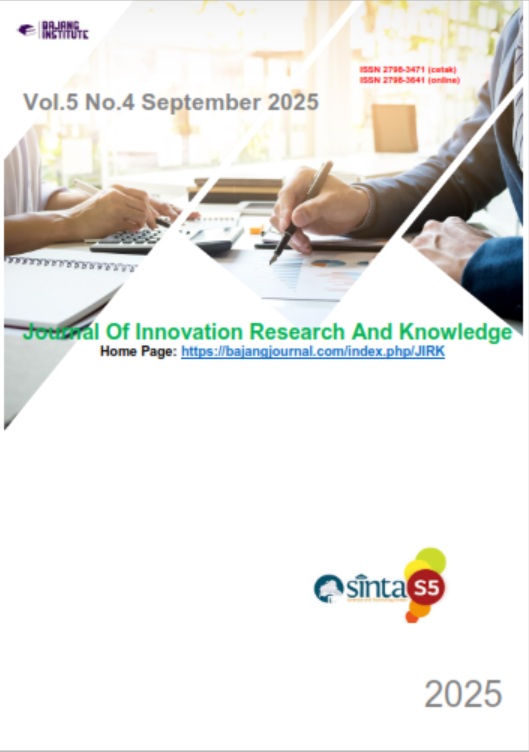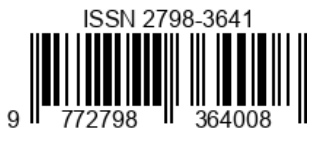PENGEMBANGAN INSTRUMEN IDENTITAS SAINS BERBASIS FRAMEWORK PISA 2025 PADA DIMENSI SCC, AC, DAN EC
DOI:
https://doi.org/10.53625/jirk.v5i4.11328Keywords:
Instrumen Identitas, Framework, Dimensi SCC, AC, ECAbstract
P enelitian ini bertujuan mengembangkan dan menguji validitas serta reliabilitas Science Identity Self-Test (SIST) yang diselaraskan dengan PISA 2025 Science Framework pada tiga dimensi: Science Capital Constructs (SCC), Attitudinal Constructs (AC), dan Environmental Constructs (EC). Instrumen dikembangkan menggunakan Metode Pengembangan Instrumen berbasis model ADDIE, dengan partisipasi 212 mahasiswa Program Studi Pendidikan IPA Universitas Trunojoyo. Analisis dilakukan menggunakan model Rasch melalui perangkat lunak Winsteps dengan estimasi Joint Maximum Likelihood Estimation (JMLE) untuk mengubah data mentah menjadi skala logit. Hasil uji validitas menunjukkan nilai rata-rata outfit mean square (MNSQ) pada seluruh dimensi berada mendekati standar ideal (1.00–1.03) dan outfit z-standardized (ZSTD) dalam batas ±2, mengindikasikan konsistensi butir dengan model Rasch. Nilai pemisahan item (4.00–8.55) dan pemisahan orang (1.46–2.95) menunjukkan kemampuan instrumen yang membedakan tingkat kesulitan butir dan variasi kemampuan responden. Uji reliabilitas menghasilkan keandalan item sangat baik hingga istimewa (0.94–0.99) serta keandalan orang cukup hingga baik (0.68–0.90), menandakan kestabilan pengukuran kemampuan responden dan urutan kesulitan butir yang dapat direplikasi. Temuan ini membuktikan bahwa SIST memiliki kualitas psikometrik yang kuat, valid, reliabel, dan sensitif dalam mengukur identitas sains pada populasi dengan kemampuan beragam. Instrumen ini berpotensi menjadi alat ukur terstandarisasi berdasarkan kerangka internasional untuk mendukung penguatan identitas sains di berbagai jenjang pendidikan dan konteks pembelajaran
References
L. P. Tugurian and S. J. Carrier, ‘Children’s environmental identity and the elementary science classroom’, J Environ Educ, vol. 48, no. 3, pp. 143–153, 2017, doi: 10.1080/00958964.2016.1191415.
S. Clayton, ‘Environmental Identity: A Conceptual and an Operational Definition’, in Identity and the Natural Environment, S. Clayton and S. Opotow, Eds., The MIT Press, 2003, pp. 45–66. [Online]. Available: https://direct.mit.edu/books/book/2450/chapter/65104/Environmental-Identity-A-Conceptual-and-an
X. A. Shinbrot, K. W. Jones, J. Solomon, and M. R. Escobedo, ‘Examining the influence of citizen science participation on individual volunteers in the global South: A case study of hydrologic monitors in Veracruz, Mexico’, Journal of Environmental Education, vol. 53, no. 1, pp. 6–21, 2022, doi: 10.1080/00958964.2021.1984193.
D. L. Blustein, L. E. Devenis, and B. A. Kidney, ‘Relationship Between the Identity Formation Process and Career Development’, J Couns Psychol, vol. 36, no. 2, pp. 196–202, Apr. 1989, doi: 10.1037/0022-0167.36.2.196.
P. Olivos and J. I. Aragonés, ‘Psychometric properties of the Environmental Identity Scale (EID)’, https://doi.org/10.1174/217119711794394653, vol. 2, no. 1, pp. 65–74, Feb. 2011, doi: 10.1174/217119711794394653.
P. P. Shein, J. H. Falk, and Y.-Y. Li, ‘The role of science identity in science center visits and effects’, Sci Educ, vol. 103, no. 6, pp. 1478–1492, 2019, doi: 10.1002/sce.21535.
A. M. White, J. T. DeCuir-Gunby, and S. Kim, ‘A mixed methods exploration of the relationships between the racial identity, science identity, science self-efficacy, and science achievement of African American students at HBCUs’, Contemp Educ Psychol, vol. 57, pp. 54–71, 2019, doi: 10.1016/j.cedpsych.2018.11.006.
M. M. Williams and C. George-Jackson, ‘USING AND DOING SCIENCE: GENDER, SELF-EFFICACY, AND SCIENCE IDENTITY OF UNDERGRADUATE STUDENTS IN STEM’, J Women Minor Sci Eng, vol. 20, no. 2, 2014, doi: 10.1615/JWomenMinorScienEng.2014004477.
J. E. Stets, P. S. Brenner, P. J. Burke, and R. T. Serpe, ‘The science identity and entering a science occupation’, Soc Sci Res, vol. 64, pp. 1–14, 2017, doi: 10.1016/j.ssresearch.2016.10.016.
H. B. Carlone, ‘Methodological Considerations for Studying Identities in School Science’, in Identity Construction and Science Education Research: Learning, Teaching, and Being in Multiple Contexts, M. Varelas, Ed., Rotterdam: SensePublishers, 2012, pp. 9–25. [Online]. Available: https://doi.org/10.1007/978-94-6209-043-9_2
E. Madison, ‘Cultivating a science identity in underrepresented students through near-peer mentoring’, Tenth SELF International Conference, 2021, [Online]. Available: https://par.nsf.gov/biblio/10188161-cultivating-science-identity-underrepresented-students-through-near-peer-mentoring
A. Chapman and A. Feldman, ‘Cultivation of science identity through authentic science in an urban high school classroom’, Cult Stud Sci Educ, vol. 12, no. 2, pp. 469–491, 2017, doi: 10.1007/s11422-015-9723-3.
A. Y. Kim and G. M. Sinatra, ‘Science identity development: an interactionist approach’, Int J STEM Educ, vol. 5, no. 1, p. 51, 2018, doi: 10.1186/s40594-018-0149-9.
S. Soeharto, ‘Development of A Diagnostic Assessment Test to Evaluate Science Misconceptions in Terms of School Grades: A Rasch Measurement Approach’, Journal of Turkish Science Education, vol. 18, no. 3, pp. 351–370, 2021, doi: 10.36681/tused.2021.78.
B. Sumintono and W. Widhiarso, Aplikasi Model Rasch untuk Penelitian Ilmu-ilmu Sosial. Cimahi: Trim Komunikata Publishing House, 2015.
J. M. Linacre, ‘Requests for reprints should be sent to Local Independence and Residual Covariance: A Study of Olympic Figure Skating Ratings’, 2009.
W. J. Boonee·, J. R. Staver, and M. S. Yale, Rasch Analysis in the Human Sciences. USA: Springer, 2014.
V. Y. Y. Liu and S. M. Lim, ‘A psychometric evaluation of the brief resilience scale among tertiary students in Singapore’, Asia Pacific Journal of Education, vol. 42, no. 3, pp. 464–477, 2022, doi: 10.1080/02188791.2020.1845120.
I. Muhammad, L. Marina Angraini, R. Darmayanti, and R. Sugianto, ‘Students’ Interest in Learning Mathematics Using Augmented Reality: Rasch Model Analysis’, Edutechnium Journal of Educational Technology, vol. 1, no. 1, pp. 89–99, 2023, [Online]. Available: https://www.edutechnium.com/journal
W. Ling Lee, K. Chinna, and B. Sumintono, ‘Psychometrics assessment of HeartQoL questionnaire: A Rasch analysis’, Eur J Prev Cardiol, vol. 28, no. 12, pp. E1–E5, Nov. 2021, doi: 10.1177/2047487320902322.
W. P. Fisher, ‘Rating Scale Instrument Quality Criteria’, Rasch Measurement Transaction, vol. 21, no. 1095, 2007, doi: 10.4236/psych.2015.616213.
A. B. Hassan and K. Osman, ‘Rasch Analysis for Thinking Levels of Sustainability Thinking Skills Instrument Among Secondary School Students’, Malaysian Journal of Social Sciences and Humanities (MJSSH), vol. 7, no. 3, p. e001387, Mar. 2022, doi: 10.47405/mjssh.v7i3.1387.
M. Stolt, A. Kottorp, and R. Suhonen, ‘A Rasch analysis of the self-administered Foot Health Assessment Instrument (S-FHAI)’, BMC Nurs, vol. 20, no. 1, Dec. 2021, doi: 10.1186/s12912-021-00625-z.
B. D. Wright and G. N. Masters, Rating scale analysis, vol. 04, no. 12. Chicago: MESA Press, 1982.
T. Brown, T. Bonsaksen, and S. K. F. Hui, ‘An examination of the structural validity of the Physical Self-Description Questionnaire-Short Form (PSDQ–S) using the Rasch Measurement Model’, Cogent Education, vol. 6, no. 1, Jan. 2019, doi: 10.1080/2331186X.2019.1571146.
S. Soeharto and B. Csapó, ‘Assessing Indonesian student inductive reasoning: Rasch analysis’, Think Skills Creat, vol. 46, Dec. 2022, doi: 10.1016/j.tsc.2022.101132.













